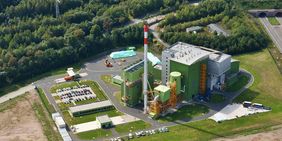
Turning waste into green fuel
Zella-Mehlis/Essen. In Zella-Mehlis in southern Thuringia, the regional “Zweckverband für Abfallwirtschaft Südwestthüringen” (ZASt) operates a waste recycling plant. By the end of 2023, a production plant for synthetic methanol will be built at that site, funded by the state of Thuringia. In a demanding two-stage, Europe-wide tendering process, STEAG, together with the planning and engineering company Dr. Born - Dr. Ermel GmbH, was awarded the contract as architect engineer to design the plant and supervise its construction.
The aim of the project, for which ZASt is to invest a total of around 23 million euros at the Zella-Mehlis site, is to produce green, climate-friendly methanol. This is widely used as a basic material in the chemical industry, for example, but can also constitute a green alternative to fossil fuels and thus contribute to the decarbonization of the mobility sector. “It is conceivable that in the future we will operate part of our own fleet of refuse collection vehicles or even bus fleets in the local transport sector with the methanol produced here. This reduces CO2 emissions, protects the environment and shows in practical terms how the energy transition can be implemented in our region,” says Thomas Müller, chairman of the ZASt association and also district administrator of Hildburghausen county.
Household waste becomes green fuel
Hydrogen (H2) and carbon dioxide (CO2) are needed to turn the residual waste from around 480,000 Thuringians into climate-friendly synthetic methanol. When the two substances react together using a special catalyst, they can be converted into methanol.
“In the future, the hydrogen required will be produced directly at the Zella-Mehlis site,” says Christian Hensel, who is in charge of the project at STEAG. For this purpose, the Essen-based energy company is planning a water electrolysis plant with a capacity of 10 megawatts (MW). This will be built and operated using the electricity generated in the South Thuringia Residual Waste Treatment Plant (RABA), the waste treatment plant in Zella-Mehlis owned by ZASt.
Up to 10,000 tons of CO2 capture per year
The second technical component is a plant for CO2 capture from the waste gas flow of the waste treatment process. “In the future, up to 10,000 metric tons of CO2 will be collected year after year in this way and will therefore not end up in the environment,” says Heiko Peters, managing director of Dr. Born - Dr. Ermel GmbH. Downstream from the electrolysis and CO2 separation there will be the methanol synthesis plant proper, which will in future produce around 5,000 to 7,000 metric tons of green fuel per year in Zella-Mehlis.
Lighthouse Zella-Mehlis
“The project in Zella-Mehlis is a beacon for the recycling economy and the energy transition,” says Ulrich Sigel, head of the STEAG Energy Solutions business unit, who is also impressed by the project. This is because methanol synthesis not only succeeds in significantly reducing CO2 emissions, but also makes an important contribution to successful energy integration by helping to decarbonize mobility. “This is an important contribution to the success of the energy transition as a whole.”
In this respect, the project promises to be a real benefit for all those involved and for the region of southern Thuringia as a whole: “Our region is known for top-level sports thanks to Oberhof. Now being a pioneer in the field of methanol synthesis is also very good for our reputation as a technology region,” says Thomas Müller from ZASt.
